C2200 Dodge Grand Caravan ABS ESP lights on
Diagnose and fix C2200 Dodge Grand Caravan ABS ESP lights on
A C2200 Dodge Grand Caravan ABS ESP lights on condition can be caused by an internal failure of the anti-lock brake module (ABM). The antilock brake system (ABS) and electronic stability program (ESP) are built into the ABM.
How Dodge Caravan ABS and ESP works
Chrysler uses the Continental brand Mk25e electronic brake control system on 2008-10 Dodge Grand Caravan and Chrysler Town & County vans. The system provides ABS (Anti-lock Brake System), Electronic Variable Brake Proportioning (EVBP), Traction control (TCS), Brake assist system (BAS) and Electronic Stability Program (ESP).
The electronic brake control system uses the following components:
• Integrated Control Unit (ICU) – Hydraulic Control Unit
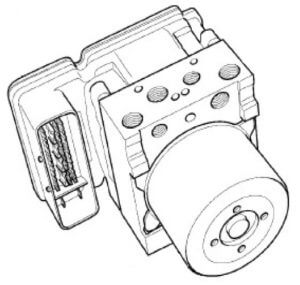
Continental Mk25e electronic brake control system ABM module
(HCU) and Antilock Brake Module (ABM)
• Four Wheel Speed Sensors (WSS)
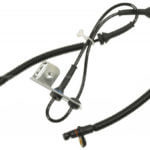
Front Wheel speed sensor
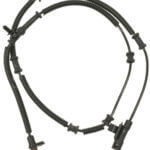
Rear wheel speed sensor
• Dynamics Sensors —a Yaw Rate Sensor and a lateral Acceleration Sensor.
• Steering Angle Sensor (SAS)
• Steering Column Control Module (SCCM) mounted on the steering column.
• Brake Pressure Sensor
ABS description
The ABS is designed to prevent wheel lockup under
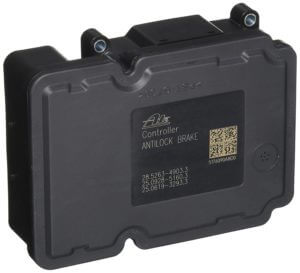
ABM control module
braking conditions on any type of road surface. ABS stops the vehicle without locking the wheels, so the vehicle maintains directional stability and some steering capability. ABS brakes allow for greater control of the vehicle during braking.
The ABS system is in operation at all vehicle speeds above 3–5 mph. If a wheel lockup tendency is detected by the wheel speed sensors during a braking application, the ABS mode activates. The ABS modulates brake fluid pressure to the four wheel circuits to prevent any wheel from locking.
Each wheel circuit has a set of electric solenoids that open or close to allow brake fluid pressure modulation. Both rear wheel solenoids receive the same electrical signal.
The system can build and release pressure at each wheel, depending on signals generated by the Wheel Speed Sensors at each wheel and received at the Antilock Brake Module (ABM).
Electronic Variable Brake Proportioning description
The Continental Mk25e electronic brake control system also includes electronic Variable Brake Proportioning which eliminates the need for a mechanical proportioning valve and balances braking effort between the front and rear brakes and reduce rear end lift during heavy braking.
The braking force of the rear wheels is controlled by using the inlet and outlet valves located in the integrated control unit (ICU).
All Speed Traction Control description
The traction control system prevents wheel slip when accelerating on slippery surfaces. It also provides directional stability control. The TCS system uses the wheel-speed sensors, along with the yaw sensor to keep the car on the intended course. All-Speed Traction Control is effective up to 85 mph.
Since the TCS system can be detrimental when accelerating from a stop in slippery conditions, the driver may turn off the TCS by pressing the ESP Off switch button located in the instrument panel switch in center of the instrument panel.
Electronic Stability Program description
The ESP provides control and stability under various driving conditions. ESP corrects for over/under steering of the vehicle by applying the brake of the appropriate wheel to counteract the over/under steer condition. The ESP may also reduce engine power to help the vehicle maintain the desired path.
ESP uses the steering angle sensor and lateral acceleration sensors to determine the intended vehicle path versus the actual path traveled. When the actual path does not match the intended path, ESP applies the brake of the appropriate wheel to counteract the oversteer or understeer condition.
Oversteer is defined as: The vehicle is turning more than the steering wheel position indicates.
Understeer is defined as: The vehicle is turning less than the steering wheel position indicates.
The ESP/TCS light flashes as soon as the tires lose traction and the ESP system activates.
Pressing the ESP Off button once activates the Partial mode. Partial mode deactivates TCS and commands the EPS to operate at a less aggressive threshold than the Full On mode.
Brake assist system description
The Brake Assist System optimizes braking capability during emergency braking. The system detects an emergency braking situation by sensing the rate and amount of brake application and then applies optimum pressure to the brakes. This can help reduce braking distances. The BAS complements the antilock brake system (ABS). Applying the brakes very quickly results in the best BAS assistance.
Diagnose C2200 trouble code
Trouble code C2200 indicates an antilock brake module internal failure. The trouble code can be caused by:
• WIRING HARNESS, TERMINAL, CONNECTOR DAMAGE
• FUSED B+ CIRCUIT(S) SHORTED TO GROUND, VOLTAGE, OR OPEN
• GROUND CIRCUIT(S) OPEN
• ANTI-LOCK BRAKE MODULE FAILURE
Disconnect the wiring harness connector at the ABM. Probe pins 1, 8 and 32 for battery power supplied by the TIPM. If you see battery power, check for ground on pins 16 and 47. If you don’t see power or ground, determine the reason before suspecting the ABM. If you do see battery and ground, the ABM is faulty and must be replaced. The new unit must be programmed to the vehicle to operate properly. If you are buying a rebuilt ABM, make sure the rebuilder programs it to your vehicle. If you buy a junkyard module, you will have to pay a shop to program it for you.
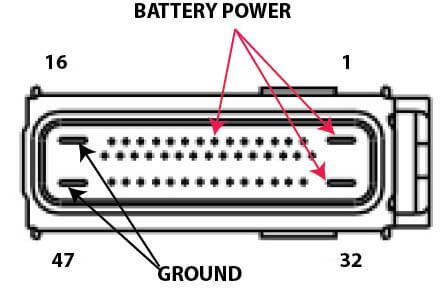
Test ABM wiring harness connector for battery voltage and ground
©, 2017 Rick Muscoplat
Posted on by Rick Muscoplat